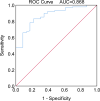Is a high-risk clinical target volume required? Evaluation of the dosimetric feasibility based on T staging
- PMID: 36119501
- PMCID: PMC9478172
- DOI: 10.3389/fonc.2022.800400
Is a high-risk clinical target volume required? Evaluation of the dosimetric feasibility based on T staging
Abstract
Background: Clinical target delineation is a primary focus in the field of radiotherapy. This study aimed to investigate whether high-risk clinical target volume can be removed in nasopharyngeal carcinoma patients with different T stages.
Materials and methods: We designed a test plan without the high-risk clinical target volume for 111 nasopharyngeal carcinoma patients and further compared the test plans with the treatment plans in the parameters of planning target volumes and the radiation dose to normal organs.
Results: Our data showed that when high-risk clinical target volume was abnegated, target coverage, conformity indices, and homogeneity indices of planning target volumes and doses of normal organs were not influenced in the T4 nasopharyngeal carcinoma patients, and more than 95% of the high-risk planning target volume area could still be covered by the 60 Gy dose line. However, only some T1-3 patients achieved the ideal dose coverage, and even fewer after induction chemotherapy (62.8% vs. 41.2%, p = 0.018). Gross tumor volume was positively correlated with the target coverage of the original high-risk planning target volume in the test-plan (p = 0.0001). Gross tumor volume can be used to predict whether the target coverage of high-risk planning target volume is more than 95% (area under the curve = 0.868).
Conclusion: Omitting high risk clinical target volume can be considered in patients with T4 nasopharyngeal carcinoma according to physical evaluations. However, this approach is only suitable for a specific subset of T1-3 patients.
Keywords: IMRT; T staging; nasopharyngeal carcinoma; omitting CTVp1; plan evaluation.
Copyright © 2022 Yuan, Yan, Peng, Chen, Lu, Gong, Qiu, Xiong, Ao, Li, Li and Tu.
Conflict of interest statement
The authors declare that the research was conducted in the absence of any commercial or financial relationships that could be construed as a potential conflict of interest.
Figures




Similar articles
-
Dosimetric comparison between 2-dimensional radiation therapy and intensity modulated radiation therapy in treatment of advanced T-stage nasopharyngeal carcinoma: to treat less or more in the planning organ-at-risk volume of the brainstem and spinal cord.Med Dosim. 2007 Winter;32(4):263-70. doi: 10.1016/j.meddos.2007.02.006. Med Dosim. 2007. PMID: 17980826
-
Intensity-modulated radiotherapy in nasopharyngeal carcinoma: dosimetric advantage over conventional plans and feasibility of dose escalation.Int J Radiat Oncol Biol Phys. 2003 May 1;56(1):145-57. doi: 10.1016/s0360-3016(03)00075-0. Int J Radiat Oncol Biol Phys. 2003. PMID: 12694833
-
[Dosimetric analysis of radiotherapy with middle shielding blocks of different widths at the lower cervical supraclavicular field for stage N2-3 nasopharyngeal carcinoma].Ai Zheng. 2007 Oct;26(10):1127-32. Ai Zheng. 2007. PMID: 17927886 Chinese.
-
Dosimetric comparison of intensity modulated radiotherapy and intensity modulated proton therapy in the treatment of recurrent nasopharyngeal carcinoma.Med Dosim. 2022 Spring;47(1):14-19. doi: 10.1016/j.meddos.2021.07.002. Epub 2021 Aug 29. Med Dosim. 2022. PMID: 34470708
-
The dosimetric comparison of the radiotherapeutic plans between composite and synchronous planning approaches in sequential IMRT for nasopharyngeal carcinoma.Int J Clin Exp Med. 2015 Sep 15;8(9):15975-82. eCollection 2015. Int J Clin Exp Med. 2015. PMID: 26629101 Free PMC article.
References
-
- Moon SH, Cho KH, Lee CG, Keum KC, Kim YS, Wu HG, et al. . IMRT vs. 2D-radiotherapy or 3D-conformal radiotherapy of nasopharyngeal carcinoma : Survival outcome in a Korean multi-institutional retrospective study (KROG 11-06). Strahlenther Onkol (2016) 192(6):377–85. doi: 10.1007/s00066-016-0959-y - DOI - PubMed
-
- Peng G, Wang T, Yang KY, Zhang S, Zhang T, Li Q, et al. . A prospective, randomized study comparing outcomes and toxicities of intensity-modulated radiotherapy vs. conventional two-dimensional radiotherapy for the treatment of nasopharyngeal carcinoma. Radiother Oncol (2012) 104(3):286–93. doi: 10.1016/j.radonc.2012.08.013 - DOI - PubMed
-
- Peters LJ, O'Sullivan B, Giralt J, Fitzgerald TJ, Trotti A, Bernier J, et al. . Critical impact of radiotherapy protocol compliance and quality in the treatment of advanced head and neck cancer: results from TROG 02.02. J Clin Oncol (2010) 28(18):2996–3001. doi: 10.1200/JCO.2009.27.4498 - DOI - PubMed
LinkOut - more resources
Full Text Sources

